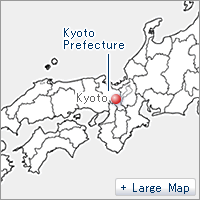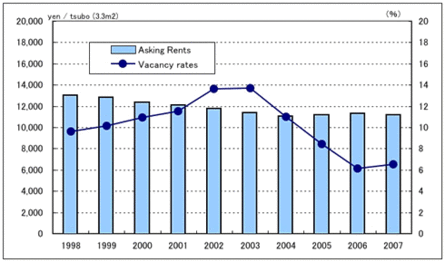(1) Location & Access

- It is located roughly 2 hours and 20 minutes from Tokyo by bullet train. Kyoto Station and Osaka Station are only 30 minutes away from each other on the JR Line.
(2) Overview
Kyoto is characterized by its history and culture of more than 1,200 years, its natural surroundings, its graceful townscape and its traditional culture. It is one of the few major cities that evaded catastrophic damage during the Second World War, since the United States decided to avoid air raids on the area because of its cultural value. The number of tourists that visited Kyoto City in 2006 totaled 48 million, which was a new record for the sixth consecutive year. While it is one of the most famous tourist destinations in Japan, it has another face as a high-tech center, being home to state-of-the-art technology businesses such as NINTENDO and a concentration of universities.
The city boasts not only traditional industries such as textiles and earthenware, but also electronic component manufacturers such as OMRON and MURATA MANUFACTURING. It is also home to 24 universities and 12 junior colleges and has long been a city of education. The Kyoto International Conference Center, which is located 20 minutes north of JR Kyoto Station by subway, was opened as the only national conference center in Japan. Many international conferences have been held there, including the Kyoto Conference on the Prevention of Global Warming. The city holds more than 200 international conferences each year.

The built-up urban area, which is surrounded by mountains, has maintained the checkerboard-like grid pattern as it was originally developed. Business and commercial areas spread out on both sides of Karasuma-dori Street, which extends northward from Kyoto Station. The central business and commercial districts lie to the north of JR Kyoto Station and in the neighborhood of Hankyu Karasuma Station. The vacancy rate, which exceeded 10% from 2002 to 2003, continued to decrease and has remained around 6% since 2006.
A significant amount of idle or underutilized land can be found to the south of JR Kyoto Station. The construction of a large commercial facility is in progress on the former site of a Matsushita Electric Industrial plant (roughly 30,000 m2). Comprised of a supermarket, a cinema complex and restaurants, it will have a total sales area of 59,900 m2 and will be completed in October 2008. Another land readjustment project is also underway on the former site of the Kirin Brewery Kyoto Plant (roughly 22 ha, the plant was closed in 1999), which stretches over to adjacent Muko City.
Kyoto City presents a graceful urban townscape with temples and rows of traditional retail stores. The JR Kyoto Station Building, which was completed in 1997, gave rise to great controversy over its scenic impairment. The gigantic building stretches over 470 m from east to west and is 60 m tall, housing a hotel, a theater and a department store. In order to protect its scenery, Kyoto City enforces much stricter regulations over buildings and commercial facilities than other cities and accordingly development is much more difficult in Kyoto.
The Karasuma subway line runs from north to south in the city and the Tozai subway line crosses over it running east to west. In January 2008, the Tozai subway line extended its coverage further to the west. Improvements in regional transportation convenience and accessibility for sightseeing in the western areas are highly anticipated.
(3) Profile Data
1. Major office buildings: year completed, major owner
Omron Kyoto Center Building: 2000, Nomura Real Estate Office Fund
2. Major companies headquartered in Kyoto City
Kyocera, Rohm, Nintendo





